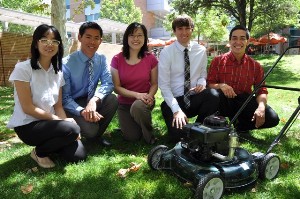Jul 8 2014
A team of University of California, Riverside Bourns College of Engineering students have won an EPA student design contest for a device they created that curbs harmful pollutant emitted from lawnmowers by 93 percent.
 From left, Wartini Ng, Timothy Chow, Kawai Tam, Jonathan Matson and Brian Cruz
From left, Wartini Ng, Timothy Chow, Kawai Tam, Jonathan Matson and Brian Cruz
The students developed the device – an “L” shaped piece of stainless steel that attaches to the lawnmower where its muffler was – because small engine devices produce significant harmful emissions. For example, the Environmental Protection Agency estimates that a gasoline powered lawn mower emits 11 times the air pollution of a new car for each hour of operation.
The grey piece is a metal mesh filter to remove particulate matter and the white piece is the catalyst support structure.
The students’ device has also fits in with UC President Janet Napolitano’s recent announcement to make the University of California system carbon neutral by 2025. With that in mind, employees responsible for maintaining the lawns at UC Riverside have agreed to pilot the students’ device. That will likely start in the coming months.
The team, which calls itself NOx-Out, believes there is a market for the device for lawnmower manufacturers and current lawnmower owners, especially operators of landscape companies, who could retrofit their existing gasoline-powered lawnmower. The device has the added benefits of reducing noise from the lawnmower and the smell of gasoline.
The students – Timothy Chow, Brian Cruz, Jonathan Matson and Wartini Ng, all of whom just graduated – won a phase one grant of $15,000 as part of the EPA’s P3 (People, Prosperity and the Planet) competition. Next year a new group of students – Anna Almario, Priyanka Singh and Alyssa Yan – will take over the project and compete for a $90,000 phase two grant.
All the students have been advised by Kawai Tam, a lecturer at the Bourns College of Engineering, Phillip Christopher, an assistant professor of chemical and environmental engineering, and David Cocker, a professor of chemical and environmental engineering.
The student team that just graduated inherited the project from another team of students that started it before graduating in 2013. They were: Joshua Callihan, Rosalva Chavez, Jonya Blahut, Risa Guysi and Holly Clarke.
That team won two first place awards in 2013 at the WERC: A Consortium for Environmental Education and Technology Development competition in Las Cruces, N.M. It’s run by the Institute for Energy & the Environment (IEE).
When they tested the device it reduced the following harmful pollutants: carbon monoxide (CO) by 87 percent; nitrogen oxides (NOx) by 67 percent and particulate matter (PM) by 44 percent. With the improved version of the device, 93 percent of particulate matter emissions were eliminated.
The device can be thought of as a three stage system. First, a filter captures the harmful pollutants. Then an ultra-fine spray of urea solution is dispersed into the exhaust stream. The urea spray primes the dirty air for the final stage, when a catalyst converts the harmful nitrogen oxide and ammonia into harmless nitrogen gas and water and releases them into the air.
The team that just graduated improved the original device in several ways:
- They added a honeycombed substrate that solidifies the catalyst. Originally, the catalyst was in a powder form and was prone to blowing out when the lawnmower was being used. Harmful emissions will likely be further reduced because they will have more contact with the substrate.
- They changed the design of the device so it is essentially one piece of L-shaped stainless steel, instead of several pieces connected through fittings. Also, the new device doesn’t stick out as far off the lawnmower.
- They eliminated the paper-thin quartz filter and replaced it with a stainless steel filter that should far outlast the quartz version.
- They added a muffler for sound reduction.
They expect the device would sell for about $30.
The incoming team will work to further improve the device. Possible areas for refinement including scaling it up so that it could be used with rider lawnmowers and develop a way to insulate it.